The list of most native plants that provide deer browse and other animals with nourishment can be categorized under “early sessional growth.” Early sessional plant growth can be achieved by a number of methods. These include tried and true timber management practices such as strip cutting or thinning, and prescribed burning. Chemical applications can produce similar results when burning is not an option. Early sessional plant growth is fostered when the immediate plant cover is removed, allowing sunlight to reach the forest floor. This allows the germination of dormant seeds and spurs regrowth of those woody plants that are well rooted.
A perfect example for study is a power line in a rural setting. The right-of-way is usually cut and/or mulched annually. It’s a simple plan that will keep access to the line open and control any trees that might grow to interfere with power transmission. Gas pipeline right-of-ways get a similar treatment. All the plants we discuss in this article are common to such areas.
Throughout much of the country pine plantations are planted on a 10’ x10’ format — trees are 10 feet apart in rows 10 feet wide. For the first few years after planting, early sessional plants grow vigorously among the newly planted pines. But pretty quickly the canopy begins to close and the forest floor becomes a desert of pine straw and little pine limbs. When it comes to deer food, it’s a barren wasteland.
There comes a time when the forest manager will remove a row, skip several rows of trees and remove another row. The results are quick and beneficial. Seeds and plants long dormant find new life and flourish in a plethora of nutritional native browse. All wildlife from quail to deer benefit from the new growth. Turkeys will get improved habitat for nesting and bugging and the land will be alive with wildlife.
In hardwood stands where mature mast producing trees have formed a closed canopy, hinge-cutting or select harvest of mature trees will produce similar results. Consult a forestry specialist; explain your goals and aspirations and a workable solution can be reached. If you have land enrolled in CRP (or some similar program) mowing or bush-hogging might be required. Building access roads and fire-lanes are another way to open the land to new early sessional natural browse. Many gamekeepers can add to the annual supplemental feeding effort with simple land management. Following is a list of some of our wildlife’s favorites.
FORBS
This is a term gamekeepers and hunters hear on a regular basis. “Forb” or “phorb” is a designation given to all those flowering herbaceous plants not classified as grasses. There are thousands of such plants and deer (ruminants) rely heavily on them for nourishment. Many are also used for human consumption.
Common ragweed (Ambrosia artemistiiflolia)
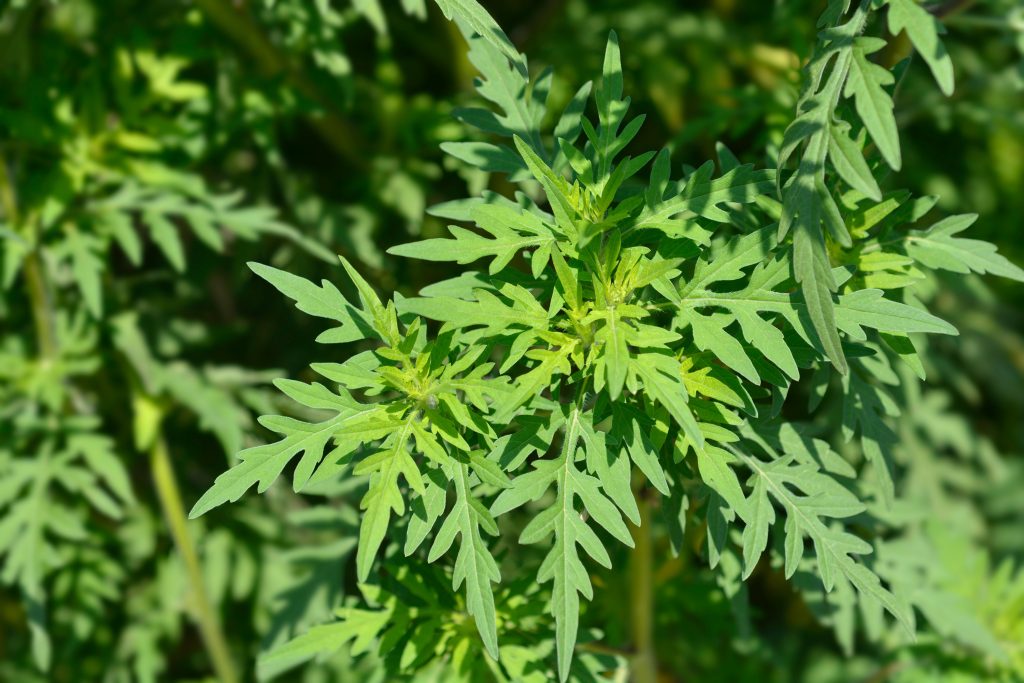
Nahhana
Found throughout the country, this black-sheep (err green sheep) of the sunflower family is the bane to the existence of many allergy suffers. Any gamekeeper with enough time in the seat of a tractor in the fall can attest to the sickening green clouds of pollen coming off the scant flowers of this plant. I have to wonder if some sadistic botanist had that in mind when this plant was given the name “Ambrosia,” being far from the “food of the gods.” But to a deer it is worthy of kudos. Providing an average of 19.6 % protein it is a staple in a deer’s late summer and early fall diet.
The lacy leaves make this plant easy to find where soil has been disturbed, such as roadsides, log-loading ramps and sometimes your food plots. It is common in power line and pipeline rights of way. Pollination is accomplished by the wind.
Goldenrod (Solidago altissima)
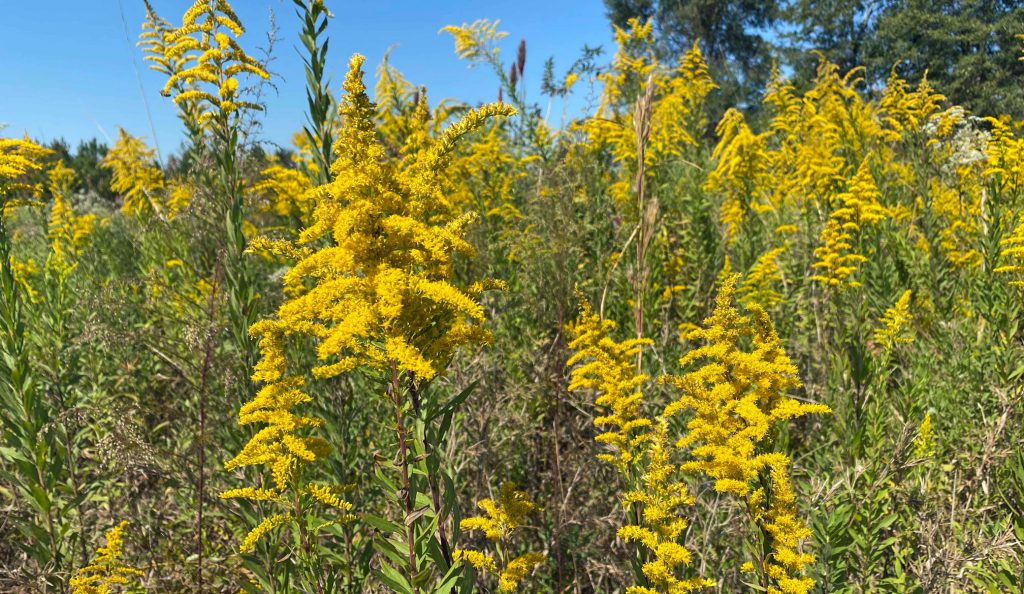
David Hawkins
Some of us will remember the naturalist Euell Gibbons wagging a stalk of goldenrod while expounding the fact it could be brewed into a delicious tea. Tasting a lot like green tea, that is true, and well accepted by many natural food enthusiasts. Blooming at the same time as ragweed, goldenrod gets a bum rap from allergy suffers who equate the plant to the former. They frequent the same environs and may even be found growing near one another.
Found from Minnesota to Florida and Texas to New England, tall goldenrod has a crude protein averaging 13.8%, but can be as high as 19% depending on soil type and plant age. Deer preference can be rated as moderate to high depending on species. They prefer sunlight and seeds are nutlets that are spread by wind or animals.
Tick-trefoil (Desmodium spp)
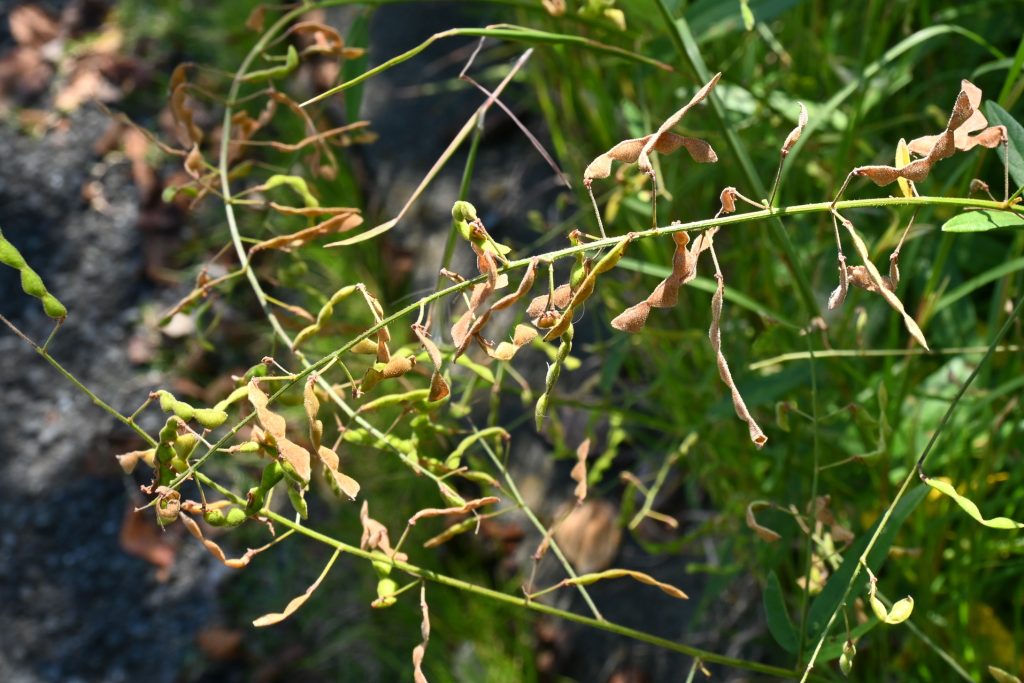
tamu1500
“Beggar lice” is just one of the common names for this pesky little plant’s seeds that hitch-hike on pant-legs, boot laces and dog hair for relocation. There are many species, some erect and some prostate with minor differences in seed pods, stems and flowers. Missouri alone has documented 14 different beggar lice plants.
Deer preference for these plants is moderate to high and it is easy to understand. The seeds, limbs, and tender stalks can provide an average of 19.1% crude protein (rates vary from 14.4 to 19). Quail and other ground feeding birds also benefit from the seeds that tend to last on the plant well into fall and winter. I have some in the curtilage of several food plots. When I tried to find a plant to photograph, all the seed pods had been eaten.
Wild Lettuce (Lactuca spp)
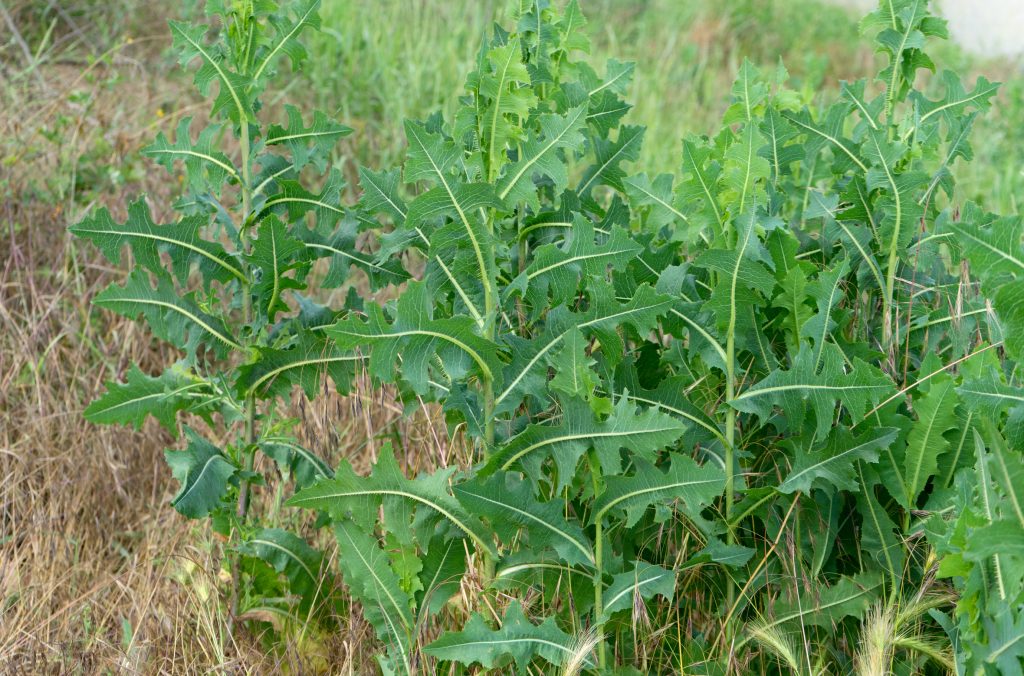
Cora Mueller
This is a deer favorite that in its early stages is often confused with thistle. Unlike the latter, the lettuce does not have the sticker-like leaves. Perhaps that is a disguise to keep animals from eating it, but doesn’t fool whitetails. This highly palatable plant boasts an average crude protein of 13.2%. These plants are annual and biennial cool-season forbs. A flowering arises forms a basal rosette and ranges from three to five feet tall. Wild lettuce is an invader in open and semi-open areas. They are some of the first to be seen in spring. Some varieties are fit for human consumption. Leaves are eaten with salad greens.
Partridge Pea (Chamaecrista spp)
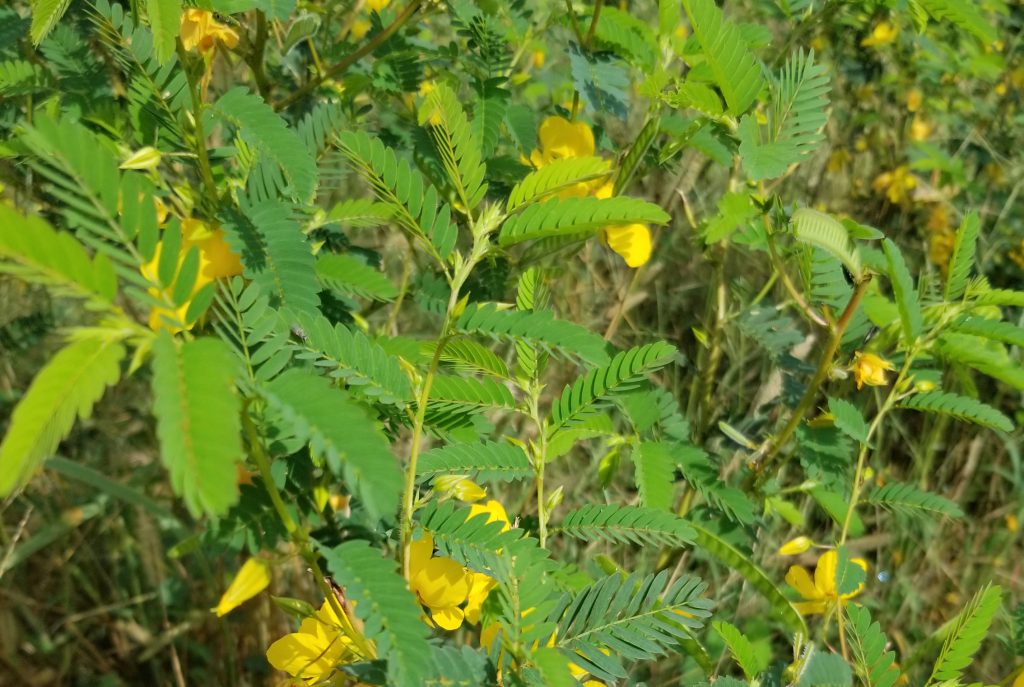
Henri Watson
What’s not to love about these showy little plants: bright yellow flowers, delicate leaves on brownish stems, and little pods of high protein peas. Critters love them. The small pea pods, containing 4 to 20 peas, ripen in late fall and winter. The plants grow in old fields and along roadsides where the seeds may persist in the soil bank for years until a prescribed burn or soil disturbance triggers germination. The Partridge pea is and annual legume, so it aids in adding nitrogen to the soil. Crude protein ranges from 15.7 to 19.2 percent.
Seed may be collected from matured plants or bought online from a number of sources. This is a great choice for the gamekeeper wanting to serve a wide variety of animals with a single planting, and enjoy the beauty as well.
Pokeweed (Phytolacca americana)
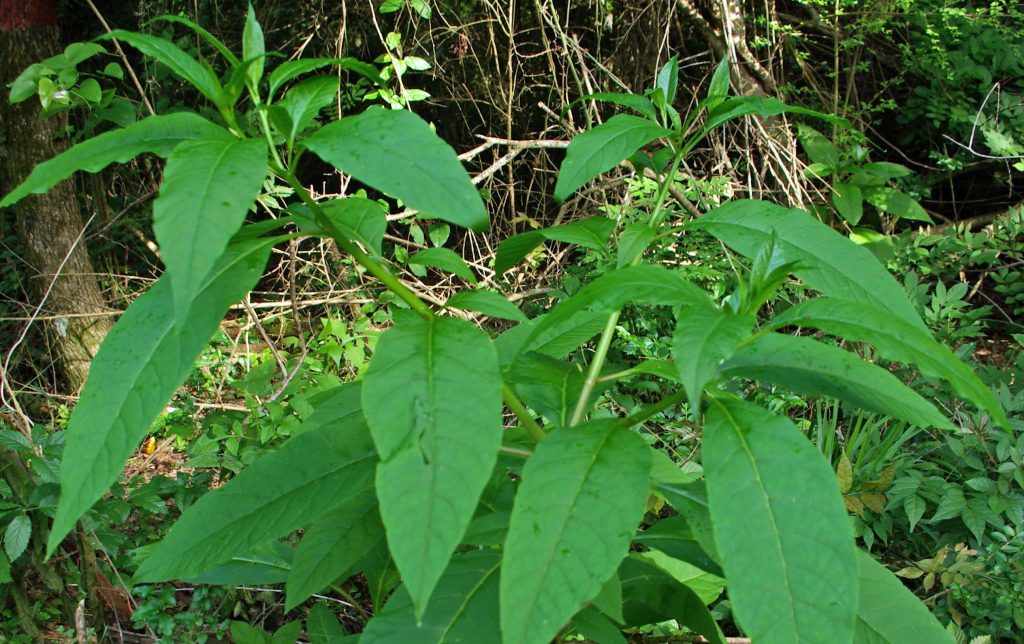
David Hawkins
Poke is another of those wild plants that deer and humans share. It has an average protein content of almost 26%! Just like people, deer prefer the tender young leaves in spring, but plants will add new growth during the warm weather growing season if it is cut down or harvested. Poke grows where soil is disturbed. Log loading sites, sites where dozer work has been done or the edge of mechanically made clearings.
The stems of the plant turn red with age and that serves as a warning to humans not to eat them once that happens. The purple berries are eaten and spread by birds and small mammals. The roots of the poke are huge and potato-like. Those roots can be prepared into a tincture for use in herbal medicine. Deer love this plant! GameKeepers can dig the roots or collect the berries to start their own, or order seed from sources that sell herbal plants.
Wild Sunflowers (Helianthus spp)
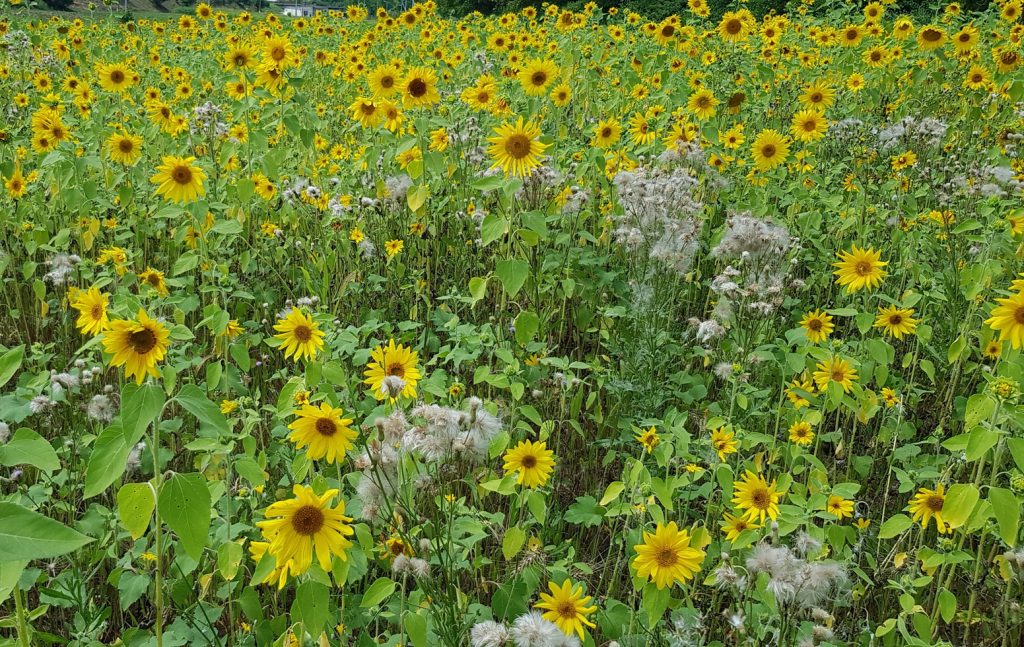
irina raduga
Wild sunflowers are erect perennials that arise from basal rosettes and can grow three to five feet tall. They persist after soil disturbances and occur in new or thinned forest plantations, rights-of-way, road sides and forest edges. A common wild flower, they grow in many soil types and provide deer with 13 to15% protein. Deer eat the flower heads and new green vegetative growth in mid to late-summer.
There are many sub-species of wild sunflowers with the center cones varying from black to purple. Petal counts can also vary with an average of eight to ten thin yellow petals. Deer preference is said to be moderate.
Old Field Asters (Aster spp)
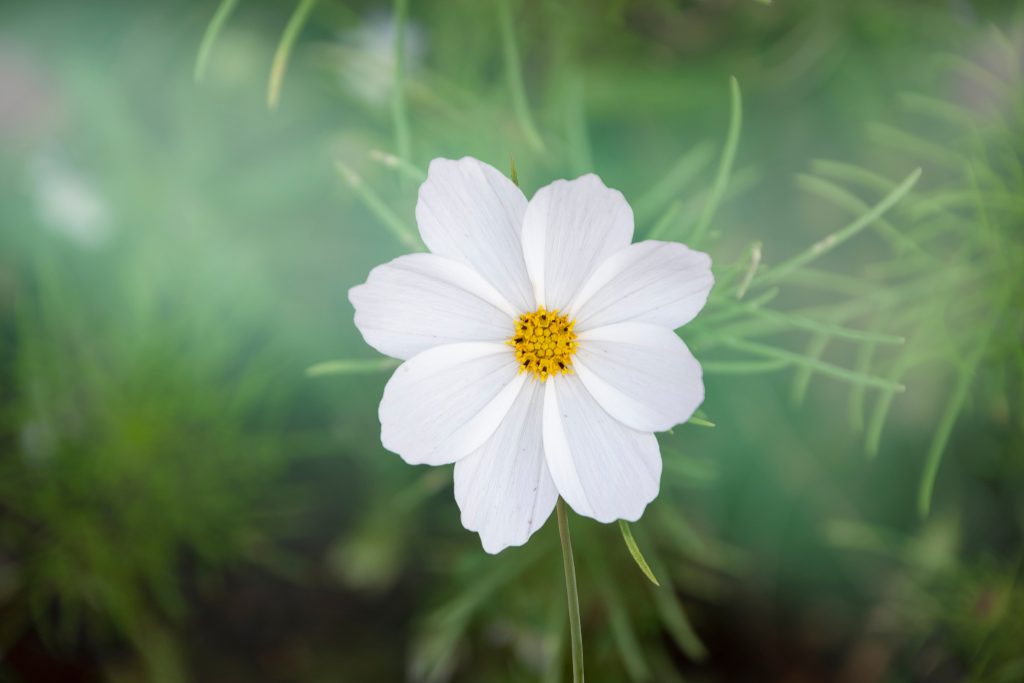
Brita Seifert
Apparently deer had rather smell the flowers than eat them when it comes to some of the dozens of asters growing wild. Deer prefer the basal rosettes in winter and early spring and the leaves and tender stems in spring and summer. From those plant parts deer will get about 13% or more of their daily protein needs. An expert is required to differentiate between all the white asters. Just know they are pretty as well as nutritious.
WOODY VINES & SEMI-WOODY PLANTS
Alabama Supplejack (Berchemia scandens)
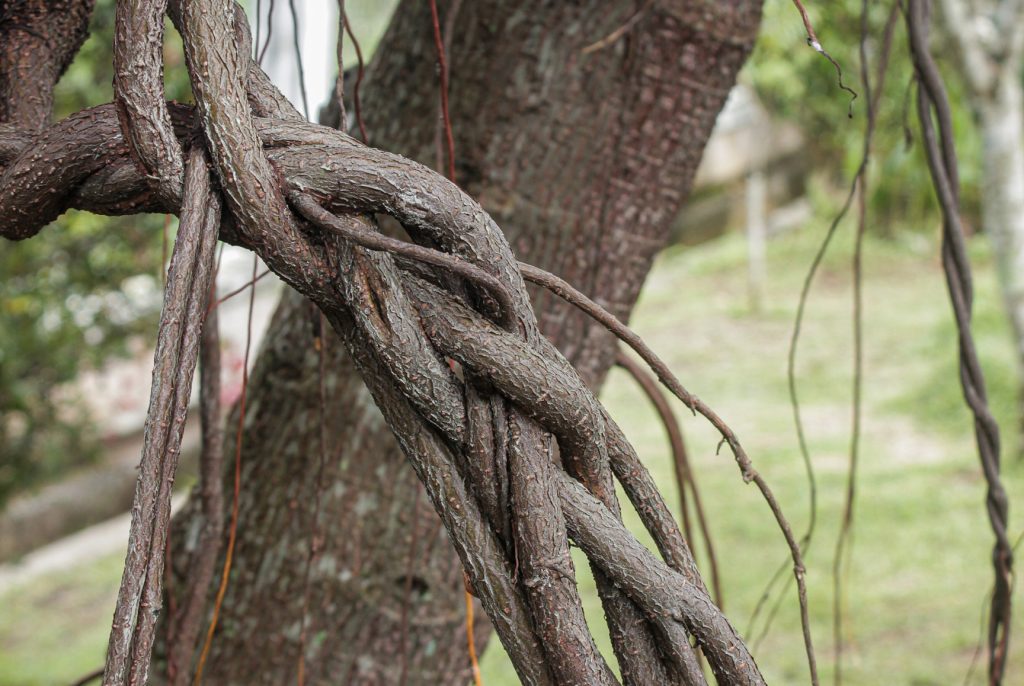
Dany Onesstone
Also known as rattan vine, I was surprised to see it listed as a deer favorite. With a protein content near 13%, deer favor the new leaf growth (although not shown in the photo). It grows abundantly on the natural prairie across our coastal plains states. The vines are strong enough to choke the life out of some trees, and squirrels find these great hiding places. The tough vines are used in some locales for making furniture.
Green briar (Smilax spp)
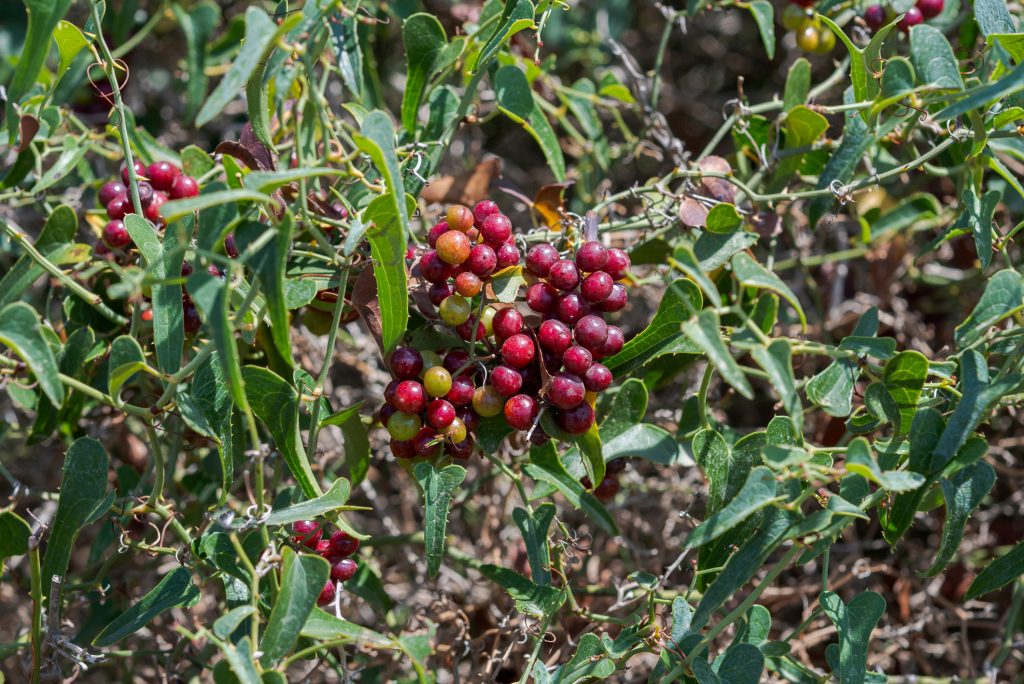
Israle Hervas
If there is a deer mainstay it has to be green briar. Found in a wide variety of environs, most, but not all species of greenbrier are eaten by white-tailed deer. The plants grow from rhizomes and are spread by birds, which eat the berry fruit. Transplanting a rhizome will get the job done if you have a place where the plant is wanted. Green briar provides 8.5 to 23.5% crude protein content, with an average of 12 to 13 percent.
Poison Ivy (Toxiciderndron radicans)
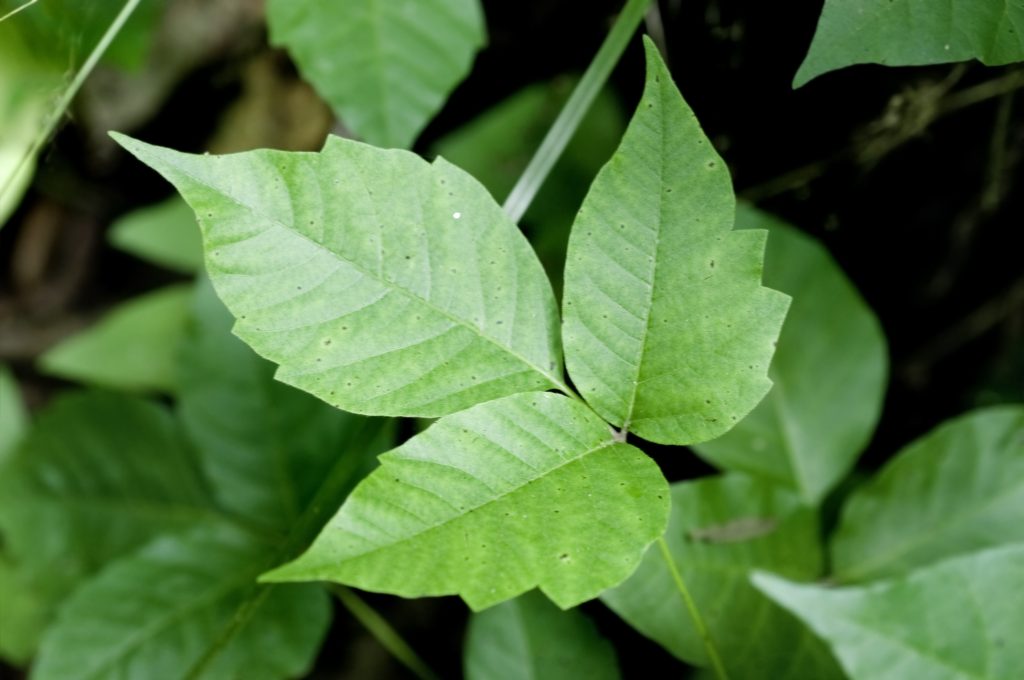
Tim Mainiero
The Coasters made a hit in 1959, with a rock and roll classic titled “Poison Ivy.” That may be the wicked little plant’s only redeeming value. That and the fact deer seem to be safe from the toxic effects of the plants chemical (urushiol), which causes a rash and itch on humans. A word to the wise, poison ivy is present in the woods during turkey season. The smoke from prescribe burns may contain the urushiol and cause irritation to the throat and lungs. Let the deer nibble on what you have, but don’t propagate the plant thinking it’s a valuable resource.
Deer give it a low to moderate preference and the foliage provides less than 12% crude protein. Leaves of three, leave them be!
Southern Dewberry (Rubus trivalis)
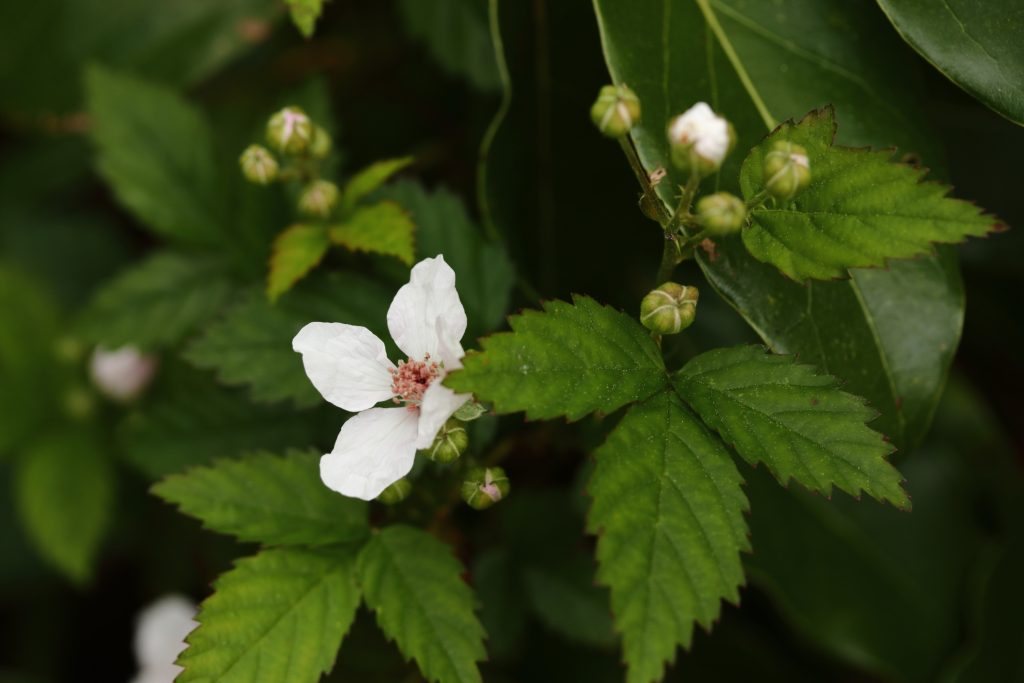
Jean Faucett
Southern dewberry is a semi-woody, trailing or low arching plant that grows in patches. It grows on a variety of sites, moist to dry, open to semi-shady habitats. Southern dewberry is a common early successional plant after timber harvests. It is easily identified by the fine-bristling, reddish thorns on the stems. The fruit ripens in April and May, just weeks ahead of its cousin the blackberry. The fruits, called drupes, are delicious made into jams or eaten fresh, or as the main ingredient in a cobbler.
Deer give them moderate to high marks and benefit from the 18% protein the plant adds to their diet.
Trumpet Creeper (Campsis radicans)
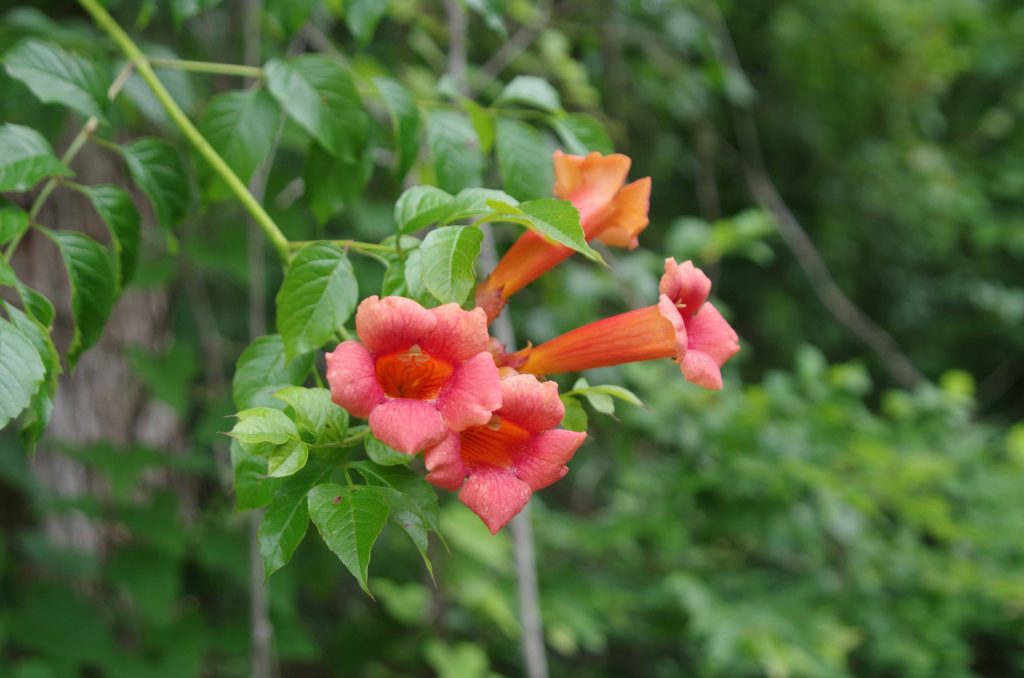
David Hawkins
High in protein (up to 28%) and growing on a sturdy vine, the trumpet creeper is a delight to numerous wildlife including deer, humming birds and pollinators. Gamekeepers with pine plantations will see the vine emerge anywhere sunlight is allowed to reach the ground. Most growth will appear I the upper reaches of the trees. Deer eat the lower portions of the vine indicating their love for the plant.
BRIARS, SHRUBS & TREES
America Beautyberry (Callicarpa americana)

Somsak Nitimongkolchai
Also known as French Mulberry deer browse on new growth and berries. These deciduous shrubs have many branches and are easily identified by the pungent smell of the crushed leaves and the unique pattern of berry growth along the stem. The leaves can actually be processed into a Deet-free insect repellant. The berries are used by some people to make jams. Leaves fall from the stalks during winter and new growth comes forth on the bare stems and from the root ball. They also add an attractive touch to the curtilage of a yard. Crude protein can range from 9.7 to 17.8%, with an average around 14.7.
Blackgum (Nyssa sylvatica)
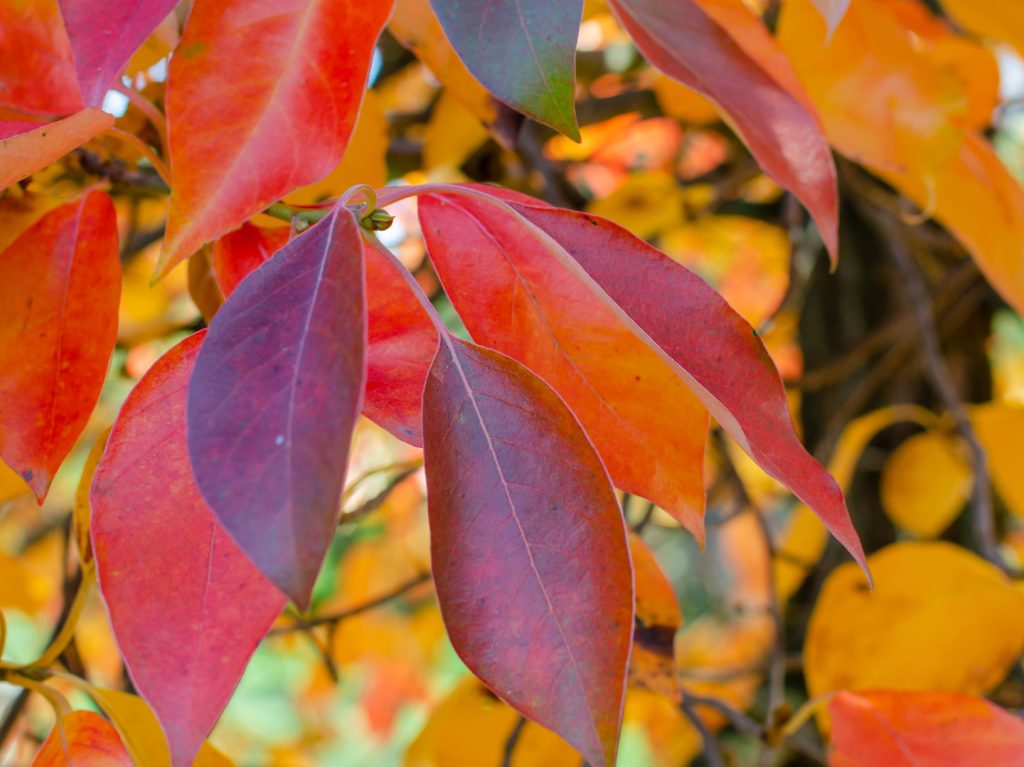
Annet Ka
The crown of the blackgum turns brilliant crimson in late summer as it ushers in the calliope of color that heralds the beginning of autumn. Every tree in the forest has a relationship with game, but the black gum stands out as one of the few deer care for directly. The tender young leaves of emerging plants offer much need protein as do the blue-black berries in the fall. Low hanging limbs of larger trees are not exempt from browsing.
Protein levels are not all that high, about 9 to 14%, but these gum trees are important to browsing herds. An interesting note is that early settlers chewed black gum twigs and perhaps used them as a sort of primitive toothbrush.
Huckleberries or Wild Blueberries (Vaccinium elliottli)

Christopher Landis
Huckleberries, to the untrained eye, are difficult to distinguish from domestic blue berries. They ripen at similar times, and eaten right off the bush taste a lot alike. They produce fine cobblers. The spring variety produces ripe fruit in March to June. A fall ripening variety produces much smaller, seedier berries in early fall. Deer will eat both but prefer the former. Depending on soil, the percent of crude protein ranges from 5.8 to 20.8 percent.
Blackberry (Rubus argutus)
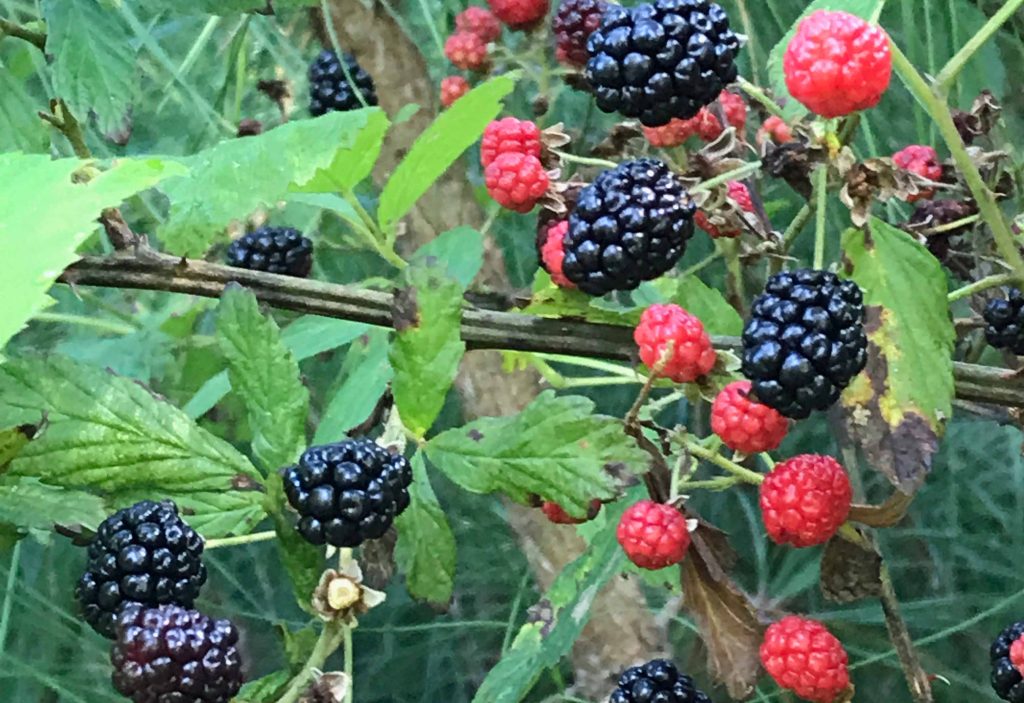
David Hawkins
Blackberry is an arching or erect, semi-woody, shrub-like plant that grows singly or in dense colonies. It grows in a variety of sites and is a common early successional plant after timber harvest. Deer eat the new growth and ripe fruits, which ripen April through June (depending on your region). Many animals benefit from blackberry, including mammals, and birds. Snakes like to hang out in berry patches to pick off a careless bird or rodent and scare the Dickins out of people picking a mess of berries for a cobbler or pie. Blackberries offer crude protein in the 10 to14% range.
This is by no means a complete listing of deer browse, just an inkling of what is available for the gamekeeper and some of our wildlife’s favorites. While a deer’s home range is a subject for another article, deer will stay close to where they’re offered sanctuary, and where food and cover are abundant.









